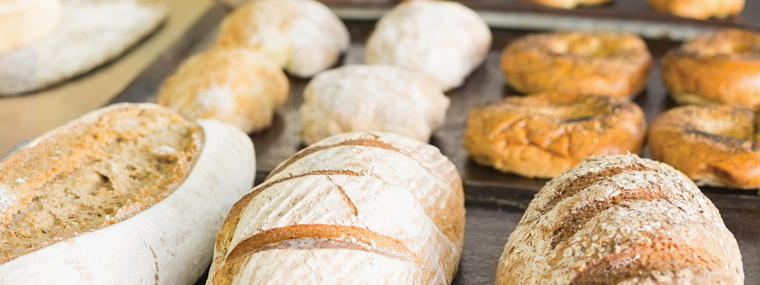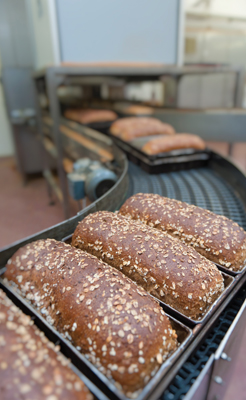
Finding the Best Fit
Cleaning Bakeries
By Diane M. Calabrese / Published September 2017

As an all-around insecticide and rodenticide, high heat gets the job done. Long before lumber was heat-treated in kilns and exterminators blew heated air from propane-fueled portable systems through bed-bug infested homes, the high heat of bakery ovens reduced undesirable organisms to a memory.
French bread just pulled from a bakery oven is about as hygienic a food as one can find. The problem is that rarely does bread or any bakery item go directly from oven to consumer. Modern bakeries are manufacturing plants where goods are baked, sorted, and packaged. As a result, baked goods leaving a facility may be contaminated at many junctures.
The U.S. Food & Drug Administra-tion (FDA) administers Title 21, Code of Federal Regulations (21 CFR), Part 110.5, Current Good Manufacturing Practice (CGMP) regulation for foods. An FDA visit to a bakery can lead to multiple citations. (Use any search engine to find warning letters to bakeries that cite violations; we do not want to highlight violations of particular bakeries here.)
On the long lists of violations the FDA typically finds are insects, plugged drains, dust and oil on surfaces used for packaging or cutting, and oil on floors. (Sadly, a lack of hand washing is another common transgression.)
Assisting bakeries with their cleaning needs—whether as a manufacturer, distributor, or contractor—means being fully conversant in CGMP requirements. For example, there are strict moisture levels for plants where baked goods are assembled, and cleaning cannot alter them. Similarly, sanitization must be done without adversely affecting the baked product.
The stringent requirements placed on bakeries have not impeded their activities. So, there is plenty of opportunity for members of our industry who can provide appropriate cleaning services.
The American Bakers’ Association (ABA), which was founded in 1897, has more than 1000 members (baking facilities and baking company suppliers). And the U.S. Bureau of Labor Statistics (BLS) assesses the profession of baker as one that will continue to grow in its number of jobs. ABA reports that the baking industry accounts for more than $102 billion in economic activity annually.
One of the stressful factors the BLS cites for bakers is coordination with other production workers, especially maintenance staff. Ensuring that equipment is clean, ready for use, and consistently meets CGMP requirements is complex.
The exacting food safety requirements seem to be leading to some changes in the approach that bakeries take to cleaning. Pressure washers continue to play a role, but they must be used in compliance with overall requirements established by CGMP.
“Many equipment dealers we work with have sold dozens of pressure washers to a single bakery plant in the past,” says Yujin Yoo Anderson, general manager and owner of Steamericas in Inglewood, CA. “This was and still is a common method to get the job done. However, we have been getting feedback that due to lack of drains, moisture sensitivity of computerized equipment, and environmental risks, including food safety, bakery customers are looking for alternative ways to clean and sanitize.”
Specificity and Steam
There are many challenges to cleaning bakeries. “The biggest challenge is probably that there is no such cleaning equipment as one-size-fits-all or all-in-one,” says Yoo Anderson. “Bakery cleaning and sanitation applications are very niche-oriented as bakery processing equipment is often custom made.”
Manufacturers and dealers who are willing to take the time to appreciate the unique needs of a particular bakery will find receptive customers. “I believe that it’s not necessarily the features or performance of the cleaning equipment that makes the sale, but more importantly, it’s the dedication, flexibility, and resourcefulness of the dealer that makes the sale,” says Yoo Anderson. “I would say this for any other market, but it is especially true for selling to bakery customers.”
 Bakeries often require different types of cleaning within the same plant. That means there are opportunities for methods built around conventional pressure washers, steam cleaners, dry ice pellets, and manual cleaning.
Bakeries often require different types of cleaning within the same plant. That means there are opportunities for methods built around conventional pressure washers, steam cleaners, dry ice pellets, and manual cleaning.
“Specifically, regarding steam, sticky food residues can be hard to remove from the types of conveyor belts bakeries often use,” says Yoo Anderson. “Since dry steam has relatively low psi, the cleaning process can be slower.”
As for contributing to the moisture level at a bakery, which would not be welcome, Yoo Anderson allays concerns regarding steam and humidity. “Dry vapor steam does not generate much overspray, if any at all,” she explains. “In fact, food safety experts agree that high temperature greater than 180 degrees Fahrenheit and lower pressure, less than 200 psi, are the ideal specifications, as higher psi spreads pathogens.”
Yoo Anderson cautions, though, that the humidity constraints differ from place to place. “Each bakery and different locations within the same bakery require unique solutions,” she explains. “Dry steam under three percent moisture can at times be deemed to have too much humidity for certain cleaning applications.”
The minimal overspray and minimal wastewater runoff from steamers have reached a receptive group. “Steamers have successfully replaced pressure washers for certain niche cleaning applications,” says Yoo Anderson. “The real beauty of steam is that it is very flexible in usage. It can be used with CIP [clean-in-place] systems, or it can be used for manual COP [clean-out-of-place]. It can be used for regular daily cleaning and sanitizing as well as PEC [period equipment cleaning].”
Yoo Anderson notes that steam cleaning is considered controlled cleaning. In that way, it contrasts with wet cleaning using a pressure washer or a dry cleaning such as sweeping.
Many methods of cleaning may be used in bakeries. “Because bakeries often need different types of cleaning within the same plant, steam can be a great asset,” says Yoo Anderson.
Dry Ice
Complementary methods of cleaning bring dry ice cleaning into the bakery picture. Dry ice is especially useful on the dry side of manufacturing. Why? “There is no secondary waste, and dry ice is a non-conductive and non-abrasive cleaner,” says Tyson Marlowe, director of global training and development at Cold Jet LLC in Loveland, OH.
“Dry ice has been used to clean proofers, ovens, bread coolers, baggers, chains, and conveyance equipment, and can even be used to clean sensitive equipment such as the blades on bread slicers,” explains Marlowe. “Bakeries have also used dry ice cleaning for general facility cleaning, which includes pipes and hoses, motors and electrical boxes, cooling fans, forklifts, and many other surfaces around the facility.”
In fact, there are so many types of cleaning in bakeries that making prudent choices requires a look at all possibilities. “Dry ice cleaning and pressure washing are complements of each other with each having benefits,” says Marlowe. “Pressure washing is fast and relatively cheap when used on the wet side of food manufacturing.”
Because a bakery does not have to wrap or mask equipment before cleaning with dry ice pellets, it saves time. Moreover, because dry ice pellets sublimate, they do not create secondary waste. Dry ice allows much equipment to be cleaned in place with limited or no disassembly.
“Dry ice cleaning can be a much more efficient way to clean bakery processing and conveyance equipment as it can be done in place, it’s a dry process, and it won’t damage equipment,” says Marlowe. At the same time, the dry ice pellets do not interfere with the integrity of oils on the conveyor system.
“Pressure washing removes important mineral oils from the conveyor,” explains Marlowe. “The oils must be reapplied following the cleaning to ensure the conveyor is properly lubricated—a process which can add hours of downtime.”
What about the material dislodged by dry ice pellets? “Typically, bakeries will use a vacuum or broom to clean up the dislodged residue from dry ice cleaning rather than pressure washing, so as not to add water to the cleaning process,” says Marlowe.
With that, we circle back to the complexity of meeting regulations. “The greatest challenge is to clean all equipment to the highest standards, without having to dedicate too much time or resources to cleaning projects,” says Marlowe.
“A lot of equipment in bakeries is not designed to be cleaned easily,” explains Marlowe. “With traditional methods, which are laborious and time consuming, most bakeries simply do not have the downtime to deeply clean all equipment. Bakeries must schedule a set-up time, disassembly and shutdown time, and time dedicated to cleaning up secondary waste.”
By choosing the fastest and most effective cleaning method, bakeries can recapture time and often reduce costs. Marlowe has case studies of bakeries that reclaimed time by using dry ice pellets to clean. One bakery was able to reduce the number of sanitation staff as well as redeploy some members of the staff to cleaning and maintenance duties in other parts of the plant.
Finally, Marlowe reminds us that colorless, tasteless, odorless, and non-toxic dry ice is a food grade media that is EPA, FDA, and USDA approved for use around food manufacturing. Dry ice eliminates the use of chemicals and potential exposure of workers to hazardous cleaning agents.
In short, cleaning bakeries is all about finding the best fit between cleaning method and the individual bakery.





